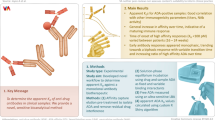Abstract
Immunogenicity is a major challenge for protein therapeutics which can potentially reduce drug efficacy and safety and is often being monitored by anti-drug antibody (ADA) and neutralizing antibody (NAb) assays. Circulating targets and residual drugs in matrices can have significant impacts on accuracy of results from ADA and NAb assays, and sufficient drug and target tolerance for these assays are necessary. Here, we report the development of a competitive ligand binding (CLB) NAb assay for an anti-TFPI (tissue factor pathway inhibitor) monoclonal antibody (PF-06741086) with high drug and target tolerance to support ongoing clinical studies. A double acid affinity capture elution approach was used to mitigate drug interference, and a robust target removal strategy was employed to enhance target tolerance. The validated NAb assay has sensitivity of 313 ng/mL, drug tolerance of 50 μg/mL, and target tolerance of 1200 ng/mL. A step-by-step tutorial of assay development is described in this manuscript along with the rationale for using a high drug/target tolerant NAb assay. The NAb assay cut point factor obtained was 0.78. Other assay performance characteristics, e.g., precision and selectivity, are also discussed. This validated method demonstrated a superior drug and target tolerance to warrant specific and precise characterization of the NAb responses in support of ongoing clinical studies.





Similar content being viewed by others
References
Buttel IC, Chamberlain P, Chowers Y, Ehmann F, Greinacher A, Jefferis R, et al. Taking immunogenicity assessment of therapeutic proteins to the next level. Biologicals. 2011;39(2):100–9.
Koren E, Smith HW, Shores E, Shankar G, Finco-Kent D, Rup B, et al. Recommendations on risk-based strategies for detection and characterization of antibodies against biotechnology products. J Immunol Methods. 2008;333(1–2):1–9.
Mire-Sluis AR, Barrett YC, Devanarayan V, Koren E, Liu H, Maia M, et al. Recommendations for the design and optimization of immunoassays used in the detection of host antibodies against biotechnology products. J Immunol Methods. 2004;289(1–2):1–16.
Shankar G, Devanarayan V, Amaravadi L, Barrett YC, Bowsher R, Finco-Kent D, et al. Recommendations for the validation of immunoassays used for detection of host antibodies against biotechnology products. J Pharm Biomed Anal. 2008;48(5):1267–81.
Shankar G, Pendley C, Stein KE. A risk-based bioanalytical strategy for the assessment of antibody immune responses against biological drugs. Nat Biotechnol. 2007;25(5):555–61.
EMA. Guideline on Immunogenicity assessment of 6 biotechnology-derived therapeutic proteins. 2015.
FDA. Guidance for industry. In: Immunogenicity assessment for therapeutic protein products; 2014.
Hu J, Gupta S, Swanson SJ, Zhuang Y. A bioactive drug quantitation based approach for the detection of anti-drug neutralizing antibodies in human serum. J Immunol Methods. 2009;345(1–2):70–9.
Zhong ZD, Clements-Egan A, Gorovits B, Maia M, Sumner G, Theobald V, et al. Drug target interference in immunogenicity assays: recommendations and mitigation strategies. AAPS J. 2017;19(6):1564–75.
Cardinal M, Kantaridis C, Zhu T, Sun P, Pittman DD, Murphy JE, et al. A first-in-human study of the safety, tolerability, pharmacokinetics and pharmacodynamics of PF-06741086, an anti-tissue factor pathway inhibitor mAb, in healthy volunteers. J Thromb Haemost. 2018;16:1722–31.
Broze GJ Jr, Lange GW, Duffin KL, MacPhail L. Heterogeneity of plasma tissue factor pathway inhibitor. Blood Coagul Fibrinolysis. 1994;5(4):551–9.
Parng C, Singh P, Pittman DD, Wright K, Leary B, Patel-Hett S, et al. Translational pharmacokinetic/pharmacodynamic characterization and target-mediated drug disposition modeling of an anti-tissue factor pathway inhibitor antibody, PF-06741086. J Pharm Sci. 2018;107(7):1995–2004.
Shen M, Dong X, Tsong Y. Statistical evaluation of several methods for cut-point determination of immunogenicity screening assay. J Biopharm Stat. 2015;25(2):269–79.
Broze GJ Jr, Girard TJ. Tissue factor pathway inhibitor: structure-function. Front Biosci. 2012;17:262–80.
Zhong ZD, Dinnogen S, Hokom M, Ray C, Weinreich D, Swanson SJ, et al. Identification and inhibition of drug target interference in immunogenicity assays. J Immunol Methods. 2010;355:21–8.
Weeraratne DK, Lofgren J, Dinnogen S, Swanson SJ, Zhong ZD. Development of a biosensor-based immunogenicity assay capable of blocking soluble drug target interference. J Immunol Methods. 2013;396(1–2):44–55.
Schwickart M, Mehrzai F, Pearson J, Shaghasi N, Chavez C, Schneider A, et al. Identification and elimination of target-related matrix interference in a neutralizing anti-drug antibody assay. J Immunol Methods. 2014;403(1–2):52–61.
Song S, Yang L, Trepicchio WL, Wyant T. Understanding the supersensitive anti-drug antibody assay: unexpected high anti-drug antibody incidence and its clinical relevance. J Immunol Res. 2016:8–17.
Acknowledgements
The authors thank Lee Walus, Renee Ramsey, Glenn Miller, and Alex Birch for the preparation of critical reagents. The authors also thank the Pfizer PF-06741086 development team for their contribution to this project.
Author information
Authors and Affiliations
Corresponding author
Additional information
Publisher’s Note
Springer Nature remains neutral with regard to jurisdictional claims in published maps and institutional affiliations.
Rights and permissions
About this article
Cite this article
**ang, Y., Parng, C., Olson, K. et al. Neutralizing Antibody Assay Development with High Drug and Target Tolerance to Support Clinical Development of an Anti-TFPI Therapeutic Monoclonal Antibody. AAPS J 21, 46 (2019). https://doi.org/10.1208/s12248-019-0320-3
Received:
Accepted:
Published:
DOI: https://doi.org/10.1208/s12248-019-0320-3




